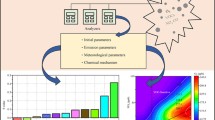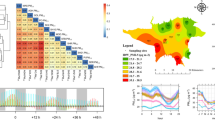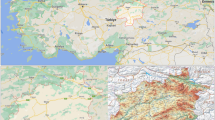Abstract
This study was concerned with the temporal analysis of benzene, toluene, ethylbenzene, xylenes (BTEXs), and ozone in Rochester, New York, between 2012 and 2018. Additionally, the influence of ozone precursors (e.g., BTEXs and NO2) and meteorological variables (e.g., relative humidity (RH), temperature along with wind speed) on ozone dispersion was investigated in the eastern half of the USA using the integrated nested Laplace approximation and stochastic partial differential equation (INLA-SPDE). The benzene variability at seasonal scale was characterized by higher values during the cold seasons. On the contrary, the long-term temporal trend of ozone depicted a repetitive cyclic behavior while an episode, with values exceeding 5 μg/m3, was detected associated with benzene in 2015. The spatial analysis by INLA-SPDE indicated that 1,3,5-trimethylbenzene and benzene were the key ozone precursors influencing ozone formation. It was demonstrated that increase of temperature had a considerable impact on ozone build-up whereas the increment of RH leads to decrease in ambient values of ozone. The amounts of root mean squared error (RMSE), mean absolute error (MAE), and bias for the validation data (e.g., 32 samples) were 0.005, 0.004, and 0.0008, exhibiting a reasonable out-of-sample forecasting by the INLA-SPDE model. The distribution map of ozone highlighted a hot spot in the state of Florida.





Similar content being viewed by others
References
Atabi F, Moattar F, Mansouri N, Alesheikh A, Mirzahosseini S (2013) Assessment of variations in benzene concentration produced from vehicles and gas stations in Tehran using GIS. Int J Environ Sci Technol (Tehran) 10:283–294
Beguin J, Fuglstad GA, Mansuy N, Paré D (2017) Predicting soil properties in the Canadian boreal forest with limited data: comparison of spatial and non-spatial statistical approaches. Geoderma 306:195–205
Beloconi A, Chrysoulakis N, Lyapustin A, Utzinger J, Vounatsou P (2018) Bayesian geostatistical modelling of PM10 and PM2. 5 surface level concentrations in Europe using high-resolution satellite-derived products. Environ Int 121:57–70
Blangiardo M, Cameletti M (2015) Spatial and spatio-temporal Bayesian models with R-INLA. John Wiley & Sons
Blangiardo M, Cameletti M, Baio G, Rue H (2013) Spatial and spatio-temporal models with R-INLA. Spatial and spatio-temporal epidemiology 4:33–49
Blangiardo M, Finazzi F, Cameletti M (2016) Two-stage Bayesian model to evaluate the effect of air pollution on chronic respiratory diseases using drug prescriptions. Spatial and spatio-temporal epidemiology 18:1–12
Bolden AL, Kwiatkowski CF, Colborn T (2015) New look at BTEX: are ambient levels a problem? Environ Sci Technol 49:5261–5276
Brocco D, Fratarcangeli R, Lepore L, Petricca M, Ventrone I (1997) Determination of aromatic hydrocarbons in urban air of Rome. Atmos Environ 31:557–566
Camalier L, Cox W, Dolwick P (2007) The effects of meteorology on ozone in urban areas and their use in assessing ozone trends. Atmos Environ 41:7127–7137
Cameletti M, Lindgren F, Simpson D, Rue H (2013) Spatio-temporal modeling of particulate matter concentration through the SPDE approach. AStA Advances in Statistical Analysis 97:109–131
Cameletti M, Gómez-Rubio V, Blangiardo M (2019) Bayesian modelling for spatially misaligned health and air pollution data through the INLA-SPDE approach. Spatial Statistics. https://doi.org/10.1016/j.spasta.2019.04.001
Carlsen L, Bruggemann R, Kenessov B (2018) Use of partial order in environmental pollution studies demonstrated by urban BTEX air pollution in 20 major cities worldwide. Sci Total Environ 610:234–243
Carstens D, Amer R (2019) Spatio-temporal analysis of urban changes and surface water quality. J Hydrol 569:720–734
Cetin E, Odabasi M, Seyfioglu R (2003) Ambient volatile organic compound (VOC) concentrations around a petrochemical complex and a petroleum refinery. Sci Total Environ 312:103–112
Chen C-H, Chuang Y-C, Hsieh C-C, Lee C-S (2019) VOC characteristics and source apportionment at a PAMS site near an industrial complex in central Taiwan. Atmospheric Pollution Research In press
Cho S, Vijayaraghavan K, Spink D, Cosic B, Davies M, Jung J (2017) Assessing the effects of oil sands related ozone precursor emissions on ambient ozone levels in the Alberta oil sands region, Canada. Atmos Environ 168:62–74
Dawson JP, Adams PJ, Pandis SN (2007) Sensitivity of ozone to summertime climate in the eastern USA: a modeling case study. Atmos Environ 41(7):1494–1511
Derwent RG, Jenkin ME, Saunders SM, Pilling MJ (1998) Photochemical ozone creation potentials for organic compounds in northwest Europe calculated with a master chemical mechanism. Atmos Environ 32(14–15):2429–2441
Duan J, Tan J, Yang L, Wu S, Hao J (2008) Concentration, sources and ozone formation potential of volatile organic compounds (VOCs) during ozone episode in Beijing. Atmos Res 88:25–35
Emami F, Masiol M, Hopke PK (2018) Air pollution at Rochester, NY: long-term trends and multivariate analysis of upwind SO2 source impacts. Sci Total Environ 612:1506–1515
Fernández-Fernández MI, Gallego MC, García JA, Acero FJ (2011) A study of surface ozone variability over the Iberian Peninsula during the last fifty years. Atmos Environ 45(11):1946–1959
Fernández-Guisuraga JM, Castro A, Alves C, Calvo A, Alonso-Blanco E, Blanco-Alegre C, Rocha A, Fraile R (2016) Nitrogen oxides and ozone in Portugal: trends and ozone estimation in an urban and a rural site. Environ Sci Pollut Res 23(17):17171–17182
Garrigues S, Allard D, Baret F, Weiss M (2006) Quantifying spatial heterogeneity at the landscape scale using variogram models. Remote Sens Environ 103(1):81–96
Giustini F, Ciotoli G, Rinaldini A, Ruggiero L, Voltaggio M (2019) Mapping the geogenic radon potential and radon risk by using Empirical Bayesian Kriging regression: a case study from a volcanic area of central Italy. Sci Total Environ 661:449–464
Gomez-Rubio V (2019) Bayesian inference with INLA. Chapman and Hall/CRC
Gorai AK, Tuluri F, Tchounwou PB, Ambinakudige S (2015) Influence of local meteorology and NO 2 conditions on ground-level ozone concentrations in the eastern part of Texas, USA. Air Quality, Atmosphere & Health 8(1):81–96
Han D, Wang Z, Cheng J, Wang Q, Chen X, Wang H (2017) Volatile organic compounds (VOCs) during non-haze and haze days in Shanghai: characterization and secondary organic aerosol (SOA) formation. Environ Sci Pollut Res 24:18619–18629
Ho KF, Lee SC, Guo H, Tsai WY (2004) Seasonal and diurnal variations of volatile organic compounds (VOCs) in the atmosphere of Hong Kong. Sci Total Environ 322:155-166.
Huang J, Malone BP, Minasny B, McBratney AB, Triantafilis J (2017) Evaluating a Bayesian modelling approach (INLA-SPDE) for environmental mapping. Sci Total Environ 609:621–632
Hui L, Liu X, Tan Q, Feng M, An J, Qu Y, Zhang Y, Jiang M (2018) Characteristics, source apportionment and contribution of VOCs to ozone formation in Wuhan, Central China. Atmos Environ 192:55–71
Iovino P, Polverino R, Salvestrini S, Capasso S (2009) Temporal and spatial distribution of BTEX pollutants in the atmosphere of metropolitan areas and neighbouring towns. Environ Monit Assess 150:437
Jia C, Mao X, Huang T, Liang X, Wang Y, Shen Y, Jiang W, Wang H, Bai Z, Ma M (2016) Non-methane hydrocarbons (NMHCs) and their contribution to ozone formation potential in a petrochemical industrialized city, Northwest China. Atmos Res 169:225–236
Kerbachi R, Boughedaoui M, Bounoua L, Keddam M (2006) Ambient air pollution by aromatic hydrocarbons in Algiers. Atmos Environ 40:3995–4003
Kerchich Y, Kerbachi R (2012) Measurement of BTEX (benzene, toluene, ethybenzene, and xylene) levels at urban and semirural areas of Algiers City using passive air samplers. J Air Waste Manag Assoc 62:1370–1379
Khoder M (2009) Diurnal, seasonal and weekdays–weekends variations of ground level ozone concentrations in an urban area in greater Cairo. Environ Monit Assess 149:349–362
Kim K-H, Kim M-Y (2002) The distributions of BTEX compounds in the ambient atmosphere of the Nan-Ji-Do abandoned landfill site in Seoul. Atmos Environ 36:2433–2446
Kim KH, Chun H-H, Jo WK (2015) Multi-year evaluation of ambient volatile organic compounds: temporal variation, ozone formation, meteorological parameters, and sources. Environ Monit Assess 187:27
Kim S-J, Kwon H-O, Lee M-I, Seo Y, Choi S-D (2019) Spatial and temporal variations of volatile organic compounds using passive air samplers in the multi-industrial city of Ulsan, Korea. Environ Sci Pollut Res 26:5831–5841
Kuo Y-M, Chiu C-H, Yu H-L (2015) Influences of ambient air pollutants and meteorological conditions on ozone variations in Kaohsiung, Taiwan. Stoch Environ Res Risk Assess 29:1037–1050
Lee S, Chiu M, Ho K, Zou S, Wang X (2002) Volatile organic compounds (VOCs) in urban atmosphere of Hong Kong. Chemosphere 48:375–382
Li J, Georgescu M, Hyde P, Mahalov A, Moustaoui M (2015a) Regional-scale transport of air pollutants: impacts of Southern California emissions on Phoenix ground-level ozone concentrations. Atmos Chem Phys 15:9345–9360
Li L, Xie S, Zeng L, Wu R, Li J (2015b) Characteristics of volatile organic compounds and their role in ground-level ozone formation in the Beijing-Tianjin-Hebei region, China. Atmos Environ 113:247–254
Li K, Chen L, Ying F, White SJ, Jang C, Wu X, Gao X, Hong S, Shen J, Azzi M, Cen K (2017) Meteorological and chemical impacts on ozone formation: a case study in Hangzhou, China. Atmos Res 196:40–52
Lin M, Horowitz LW, Payton R, Fiore AM, Tonnesen G (2017) US surface ozone trends and extremes from 1980 to 2014: quantifying the roles of rising Asian emissions, domestic controls, wildfires, and climate. Atmospheric Chemistry & Physics 15:17(4)
Lindgren F, Rue H, Lindstrom J (2011) An explicit link between Gaussian fields and Gaussian Markov random ields: the stochastic partial differential equation approach (with discussion). Journal of Royal Statistical Society Series B 73(4):423–498
Ling Z, Guo H (2014) Contribution of VOC sources to photochemical ozone formation and its control policy implication in Hong Kong. Environ Sci Pol 38:180–191
Ling Z, Guo H, Cheng H, Yu Y (2011) Sources of ambient volatile organic compounds and their contributions to photochemical ozone formation at a site in the Pearl River Delta, southern China. Environ Pollut 159:2310–2319
Liu Y, Li L, An J, Huang L, Yan R, Huang C, Wang H, Wang Q, Wang M, Zhang W (2018) Estimation of biogenic VOC emissions and its impact on ozone formation over the Yangtze River Delta region, China. Atmos Environ 186:113–128
Lyu X, Chen N, Guo H, Zhang W, Wang N, Wang Y, Liu M (2016) Ambient volatile organic compounds and their effect on ozone production in Wuhan, central China. Sci Total Environ 541:200–209
Marć M, Zabiegała B, Namieśnik J (2014) Application of passive sampling technique in monitoring research on quality of atmospheric air in the area of Tczew, Poland. Int J Environ Anal Chem 94:151–167
Marčiulaitienė E, Šerevičienė V, Baltrėnas P, Baltrėnaitė E (2017) The characteristics of BTEX concentration in various types of environment in the Baltic Sea region, Lithuania. Environ Sci Pollut Res 24:4162–4173
Martins EM, de Sá Borba PF, dos Santos NE, dos Reis PTB, Silveira RS, Corrêa SM (2016) The relationship between solvent use and BTEX concentrations in occupational environments. Environ Monit Assess 188:608
Masih A, Lall AS, Taneja A, Singhvi R (2016) Inhalation exposure and related health risks of BTEX in ambient air at different microenvironments of a terai zone in north India. Atmos Environ 147:55–66
McCarthy MC, Aklilu Y-A, Brown SG, Lyder DA (2013) Source apportionment of volatile organic compounds measured in Edmonton, Alberta. Atmos Environ 81:504–516
McKenzie LM, Witter RZ, Newman LS, Adgate JL (2012) Human health risk assessment of air emissions from development of unconventional natural gas resources. Sci Total Environ 424:79–87
Na K, Moon K-C, Kim YP (2005) Source contribution to aromatic VOC concentration and ozone formation potential in the atmosphere of Seoul. Atmos Environ 39:5517–5524
Parra MA, Elustondo D, Bermejo R, Santamaria J (2009) Ambient air levels of volatile organic compounds (VOC) and nitrogen dioxide (NO2) in a medium size city in Northern Spain. Sci Total Environ 407:999–1009
Poggio L, Gimona A, Spezia L, Brewer MJ (2016) Bayesian spatial modelling of soil properties and their uncertainty: the example of soil organic matter in Scotland using R-INLA. Geoderma 277:69–82
Rue H, Martino S, Chopin N (2009) Approximate Bayesian inference for latent Gaussian models by using integrated nested Laplace approximations. Journal of the royal statistical society: Series b (statistical methodology) 71(2):319–392
Rue H, Riebler A, Sørbye SH, Illian JB, Simpson DP, Lindgren FK (2017) Bayesian computing with INLA: a review. Annual Review of Statistics and Its Application 4:395–421
Sakizadeh M, Martín JAR, Zhang C, Sharafabadi FM, Ghorbani H (2018) Trace elements concentrations in soil, desert-adapted and non-desert plants in central Iran: spatial patterns and uncertainty analysis. Environ Pollut 243:270–281
Santurtún A, González-Hidalgo JC, Sanchez-Lorenzo A, Zarrabeitia MT (2015) Surface ozone concentration trends and its relationship with weather types in Spain (2001–2010). Atmos Environ 101:10–22
Simon H, Reff A, Wells B, Xing J, Frank N (2014) Ozone trends across the United States over a period of decreasing NOx and VOC emissions. Environ Sci Technol 49:186–195
Tohon HG, Fayomi B, Valcke M, Coppieters Y, Bouland C (2015) BTEX air concentrations and self-reported common health problems in gasoline sellers from Cotonou, Benin. Int J Environ Health Res 25:149–161
Tong DQ, Mauzerall DL (2006) Spatial variability of summertime tropospheric ozone over the continental United States: implications of an evaluation of the CMAQ model. Atmos Environ 40(17):3041–3056
Tong R, Yang Y, Shao G, Zhang Y, Dou S, Jiang W (2019) Emission sources and probabilistic health risk of volatile organic compounds emitted from production areas in a petrochemical refinery in Hainan, China. Human and Ecological Risk Assessment: An International Journal:1–21
Tran NK, Steinberg SM, Johnson BJ (2000) Volatile aromatic hydrocarbons and dicarboxylic acid concentrations in air at an urban site in the Southwestern US. Atmos Environ 34:1845–1852
Vukovich FM, Sherwell J (2003) An examination of the relationship between certain meteorological parameters and surface ozone variations in the Baltimore–Washington corridor. Atmospheric Environ 37(7):971–981
Wang G, Cheng S, Wei W, Zhou Y, Yao S, Zhang H (2016) Characteristics and source apportionment of VOCs in the suburban area of Beijing, China. Atmospheric Pollut Res 7:711–724
Yan Y, Yang C, Peng L, Li R, Bai H (2016) Emission characteristics of volatile organic compounds from coal-, coal gangue-, and biomass-fired power plants in China. Atmos Environ 143:261–269
Zheng J, Shao M, Che W, Zhang L, Zhong L, Zhang Y, Streets D (2009) Speciated VOC emission inventory and spatial patterns of ozone formation potential in the Pearl River Delta, China. Environ Sci Technol 43(22):8580–8586
Acknowledgments
The data used in the current research were results of the collective efforts of dedicated field crews, laboratory staff, data management and quality control staff, analysts, and many others from EPA, states, tribes, federal agencies, universities, and other organizations. The authors express their gratitude to all of those who contributed to the production of these data.
Author information
Authors and Affiliations
Corresponding author
Additional information
Responsible editor: Constantini Samara
Publisher’s note
Springer Nature remains neutral with regard to jurisdictional claims in published maps and institutional affiliations.
Electronic supplementary material
ESM 1
(DOCX 2282 kb)
Rights and permissions
About this article
Cite this article
Sakizadeh, M., Mohamed, M.M. Application of spatial analysis to investigate contribution of VOCs to photochemical ozone creation. Environ Sci Pollut Res 27, 10459–10471 (2020). https://doi.org/10.1007/s11356-020-07628-4
Received:
Accepted:
Published:
Issue Date:
DOI: https://doi.org/10.1007/s11356-020-07628-4




